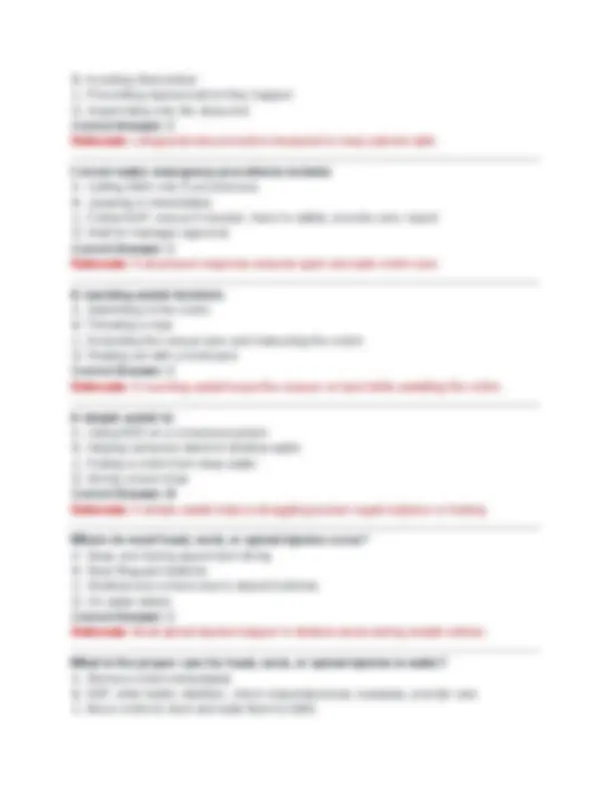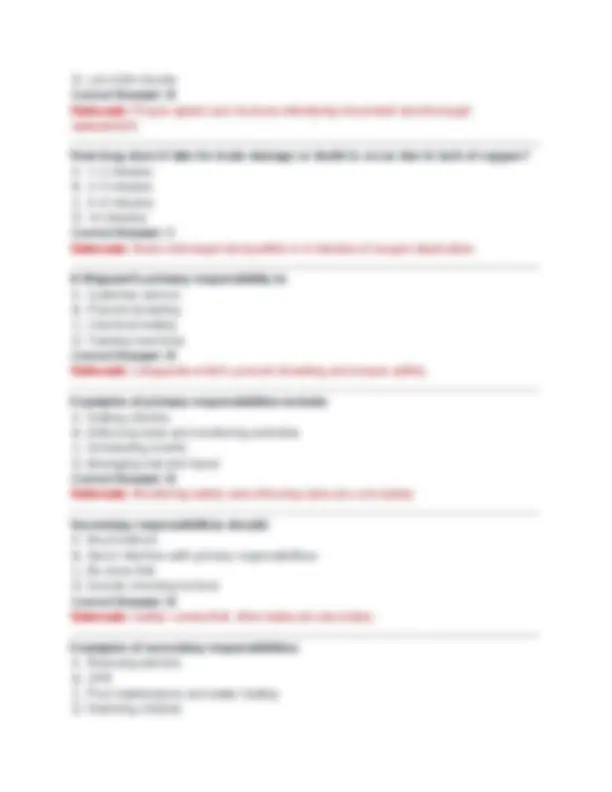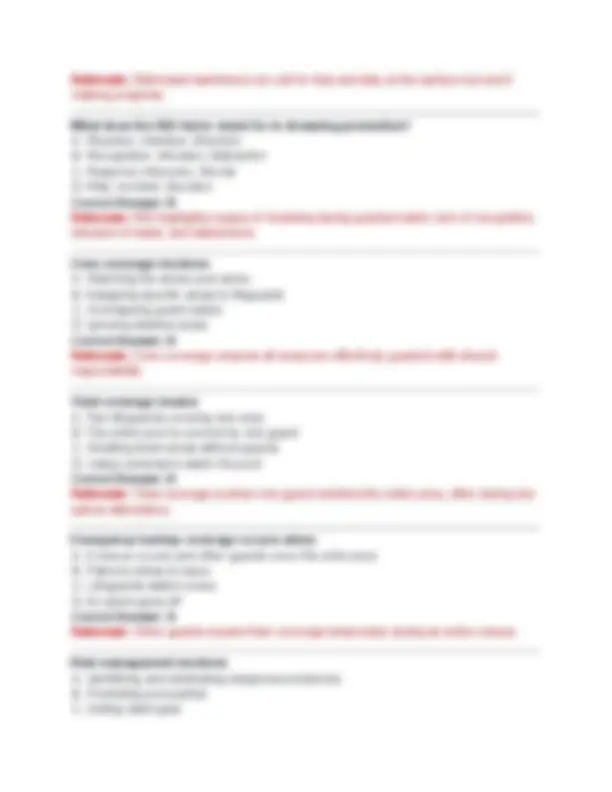






















Study with the several resources on Docsity

Earn points by helping other students or get them with a premium plan


Prepare for your exams
Study with the several resources on Docsity

Earn points to download
Earn points by helping other students or get them with a premium plan
Community
Ask the community for help and clear up your study doubts
Discover the best universities in your country according to Docsity users
Free resources
Download our free guides on studying techniques, anxiety management strategies, and thesis advice from Docsity tutors
If you are caught outside in a thunderstorm, what should you do? A. Stand under a tree B. Lay flat on the ground C. Stay near metal fences D. Stay away from trees, water, and metal, stay low, and wait 30 minutes after the last lightning or thunder Correct Answer: D Rationale: These actions reduce the risk of being struck by lightning. Waiting 30 minutes ensures the storm has passed. What should you do during heavy rain at a pool? A. Continue swimming as usual B. Check the chlorine levels C. Clear the pool if the bottom is not visible D. Allow lap swimmers to remain Correct Answer: C Rationale: If visibility is impaired, swimmers are at risk, and the pool must be cleared for safety. What should be done if hail begins during swim operations? A. Continue activities under supervision B. Give patrons umbrellas C. Clear the pool and find shelter D. Move swimmers to the shallow end Correct Answer: C Rationale: Hail poses a safety risk; swimmers should s
Typology: Exams
1 / 28

This page cannot be seen from the preview
Don't miss anything!





















If you are caught outside in a thunderstorm, what should you do? A. Stand under a tree B. Lay flat on the ground C. Stay near metal fences D. Stay away from trees, water, and metal, stay low, and wait 30 minutes after the last lightning or thunder Correct Answer: D Rationale: These actions reduce the risk of being struck by lightning. Waiting 30 minutes ensures the storm has passed. What should you do during heavy rain at a pool? A. Continue swimming as usual B. Check the chlorine levels C. Clear the pool if the bottom is not visible D. Allow lap swimmers to remain Correct Answer: C Rationale: If visibility is impaired, swimmers are at risk, and the pool must be cleared for safety. What should be done if hail begins during swim operations? A. Continue activities under supervision B. Give patrons umbrellas C. Clear the pool and find shelter D. Move swimmers to the shallow end Correct Answer: C Rationale: Hail poses a safety risk; swimmers should seek shelter immediately. What is effective surveillance for lifeguards? A. Scanning the surface periodically B. Having a whistle ready C. Recognition of dangerous behavior and zone responsibility D. Focusing only on the diving area
Correct Answer: C Rationale: Effective surveillance includes recognizing danger, knowing zones, and being ready to act. Which of the following describes a weak swimmer? A. Floating calmly B. Holding their breath underwater C. Bobbing in deep water beyond arm’s reach D. Swimming laps slowly Correct Answer: C Rationale: Bobbing in water beyond their ability is a clear sign of weakness and potential distress. Which is a sign of an active drowning victim? A. Floating on their back B. Yelling for help C. Vertical in the water with arms extended, unable to call out D. Swimming toward the ladder Correct Answer: C Rationale: Active drowning victims focus on breathing and are often unable to call for help. Which is a sign of a passive drowning victim? A. Swimming but not moving forward B. Limp, motionless, submerged C. Waving arms and calling for help D. Climbing a ladder slowly Correct Answer: B Rationale: Passive victims are unconscious and show no signs of movement or breathing. What describes a distressed swimmer? A. Not breathing and submerged B. Submerged and limp C. Clinging to the wall, breathing, and calling for help D. Moving swiftly across the pool Correct Answer: C Rationale: Distressed swimmers are conscious but need assistance and are often near exhaustion. What does the acronym RID stand for? A. Recognize, Intervene, Defend
B. Avoiding intervention C. Preventing injuries before they happen D. Supervising only the deep end Correct Answer: C Rationale: Lifeguards take proactive measures to keep patrons safe. Correct water emergency procedures include: A. Calling EMS only if unconscious B. Jumping in immediately C. Follow EAP, rescue if needed, move to safety, provide care, report D. Wait for manager approval Correct Answer: C Rationale: A structured response ensures quick and safe victim care. A reaching assist involves: A. Swimming to the victim B. Throwing a rope C. Extending the rescue tube and instructing the victim D. Wading out with a kickboard Correct Answer: C Rationale: A reaching assist keeps the rescuer on land while assisting the victim. A simple assist is: A. Using AED on a conscious person B. Helping someone stand in shallow water C. Pulling a victim from deep water D. Giving a back blow Correct Answer: B Rationale: A simple assist helps a struggling person regain balance or footing. Where do most head, neck, or spinal injuries occur? A. Deep end during supervised diving B. Near lifeguard stations C. Shallow end corners due to sloped bottoms D. On water slides Correct Answer: C Rationale: Most spinal injuries happen in shallow areas during unsafe entries. What is the proper care for head, neck, or spinal injuries in water? A. Remove victim immediately B. EAP, enter water, stabilize, check responsiveness, reassess, provide care C. Move victim to deck and walk them to EMS
D. Let victim decide Correct Answer: B Rationale: Proper spinal care involves minimizing movement and thorough assessment. How long does it take for brain damage or death to occur due to lack of oxygen? A. 1–2 minutes B. 2–3 minutes C. 4–6 minutes D. 10 minutes Correct Answer: C Rationale: Brain cells begin dying within 4–6 minutes of oxygen deprivation. A lifeguard’s primary responsibility is: A. Customer service B. Prevent drowning C. Chemical testing D. Training new hires Correct Answer: B Rationale: Lifeguards exist to prevent drowning and ensure safety. Examples of primary responsibilities include: A. Testing chlorine B. Enforcing rules and monitoring activities C. Scheduling events D. Managing lost and found Correct Answer: B Rationale: Monitoring safety and enforcing rules are core duties. Secondary responsibilities should: A. Be prioritized B. Never interfere with primary responsibilities C. Be done first D. Include checking lockers Correct Answer: B Rationale: Safety comes first; other tasks are secondary. Examples of secondary responsibilities: A. Rescuing patrons B. CPR C. Pool maintenance and water testing D. Watching children
Which of the following best defines effective surveillance? A. Watching only the deep end B. Lifeguards taking turns relaxing C. Recognition of dangerous behaviors and zones D. Making eye contact with swimmers Correct Answer: C Rationale: Effective surveillance includes identifying at-risk behavior and maintaining defined zones of responsibility. Which of the following indicates a weak swimmer? A. Floating calmly B. Bobbing in water over their head and beyond arm’s reach C. Wearing goggles and swimming laps D. Playing near the pool steps Correct Answer: B Rationale: Bobbing and inability to reach safety suggest weak swimming ability and potential for distress. Which of the following best describes an active drowning victim? A. Splashing and yelling for help B. Floating on back with eyes open C. Vertical in water, arms extended, unable to call for help D. Swimming but slowly Correct Answer: C Rationale: Active drowning victims may be silent and show limited motion focused on breathing. Which of the following best describes a passive drowning victim? A. Splashing and yelling B. Submerged, limp, not breathing C. Treading water D. Holding onto lane ropes Correct Answer: B Rationale: Passive victims are unresponsive and may appear lifeless in the water. Which of the following best describes a distressed swimmer? A. Face down, motionless B. Submerged and limp C. Clinging to the side, calling for help, breathing D. Swimming quickly toward deep water Correct Answer: C
Rationale: Distressed swimmers can call for help and stay at the surface but aren’t making progress. What does the RID factor stand for in drowning prevention? A. Reaction, Intention, Direction B. Recognition, Intrusion, Distraction C. Respond, Intervene, Decide D. Risk, Incident, Decision Correct Answer: B Rationale: RID highlights causes of drowning during guarded swim: lack of recognition, intrusion of tasks, and distractions. Zone coverage involves: A. Watching the whole pool alone B. Assigning specific areas to lifeguards C. Overlapping guard duties D. Ignoring shallow areas Correct Answer: B Rationale: Zone coverage ensures all areas are effectively guarded with shared responsibility. Total coverage means: A. Two lifeguards covering one area B. The entire pool is covered by one guard C. Shutting down areas without guards D. Using cameras to watch the pool Correct Answer: B Rationale: Total coverage is when one guard monitors the entire area, often during low patron attendance. Emergency backup coverage occurs when: A. A rescue occurs and other guards cover the extra area B. Patrons refuse to leave C. Lifeguards switch zones D. An alarm goes off Correct Answer: A Rationale: Other guards expand their coverage temporarily during an active rescue. Risk management involves: A. Identifying and eliminating dangerous behaviors B. Promoting pool parties C. Selling swim gear
C. Shallow end diving in sloped/corner areas D. Swimming laps Correct Answer: C Rationale: These injuries usually happen in shallow water when patrons dive into unexpected slopes. Procedure for head/neck/spinal injuries in water includes: A. Letting the person float until EMS arrives B. EAP, entry, stabilization, responsiveness check, provide care C. Remove them immediately and run D. Splash water on their face Correct Answer: B Rationale: The proper procedure ensures spinal precautions and minimizes further injury. How long does it take for brain damage or death to occur due to lack of oxygen? A. 10-15 minutes B. 4-6 minutes C. 20 seconds D. 2-3 minutes Correct Answer: B Rationale: Irreversible brain damage can occur within minutes of oxygen deprivation. What is a lifeguard’s primary responsibility? A. Selling snacks B. To prevent drowning C. Organizing games D. Testing pH Correct Answer: B Rationale: A lifeguard’s core duty is to ensure water safety and prevent drowning incidents. Which of the following are examples of primary responsibilities? A. Filling out time cards B. Enforcing rules and monitoring water activity C. Cleaning bathrooms D. Organizing swim meets Correct Answer: B Rationale: Direct water safety supervision is a primary duty. Secondary responsibilities should: A. Take priority over surveillance
B. Be done anytime C. Never interfere with primary responsibilities D. Be left to others Correct Answer: C Rationale: Secondary duties must not disrupt the main duty of surveillance. Which of the following are secondary responsibilities? A. Enforcing safety B. Monitoring swimmers C. Testing water and maintenance D. Rescuing patrons Correct Answer: C Rationale: While still important, these tasks must not take away from surveillance time. While in a lifeguard stand, you should: A. Eat snacks B. Look at your phone C. Be alert in athletic position D. Sit relaxed Correct Answer: C Rationale: Lifeguards should be alert and ready to respond instantly, maintaining vigilance. What does FIND stand for? A. Fast-Inspect-Navigate-Decide B. Figure out, Identify, Name pros/cons, Decide C. Feel, Intend, Notify, Direct D. Fight, Ignore, Note, Do Correct Answer: B Rationale: FIND is a problem-solving model used in non-emergency decision-making. When is FIND used? A. Only in cardiac arrest B. During rescue operations C. In non-emergency situations D. In daily fitness plans Correct Answer: C Rationale: FIND helps lifeguards resolve issues like rule enforcement or patron behavior calmly. What is the purpose of a water competency sequence? A. To assess how fast someone can swim B. To test a swimmer’s style
Rationale: This step-by-step process ensures organized, effective, and documented response to emergencies. What are standard precautions? A. Wearing goggles when outside B. Assuming all bodily fluids are infectious and using PPE C. Not touching patrons D. Washing hands only if visibly dirty Correct Answer: B Rationale: Standard precautions protect responders from bloodborne pathogens by assuming all bodily fluids may be infectious. What is PPE? A. Personal Property Equipment B. Personal Protective Equipment C. Protective Pool Essentials D. Pool Patrol Essentials Correct Answer: B Rationale: PPE includes gloves, masks, and other equipment used to protect against exposure to infections. Which of the following describes direct contact transmission? A. Coughing from a distance B. Touching a contaminated object C. Pathogen transmission through body-to-body contact D. Breathing air near someone Correct Answer: C Rationale: Direct contact involves physical contact with infected individuals or fluids. What should you do if you come in contact with blood or other potentially infectious materials? A. Wipe it off with a towel B. Wash immediately with soap and water and report the exposure C. Ignore it unless you feel sick D. Use hand sanitizer only Correct Answer: B Rationale: Immediate washing and proper reporting are essential to prevent disease transmission. Which of the following is an example of PPE? A. Whistle B. Lifeguard t-shirt
C. Disposable gloves D. Name tag Correct Answer: C Rationale: Gloves are a form of personal protective equipment that prevent exposure to bodily fluids. What should lifeguards do to stay alert while on duty? A. Drink coffee and eat snacks B. Take frequent breaks, stay hydrated, rotate stations C. Listen to music D. Sit back and relax when the pool is quiet Correct Answer: B Rationale: Regular breaks, hydration, and rotation help lifeguards maintain vigilance and reduce fatigue. What is the best way to enforce rules at the facility? A. Yell loudly at violators B. Use signage only C. Use a positive, professional tone and be consistent D. Ignore minor issues Correct Answer: C Rationale: Professional, consistent enforcement maintains safety and earns respect from patrons. Why is documentation important after an emergency? A. To blame someone B. To have paperwork for supervisors C. To record what happened for legal, medical, and safety review purposes D. To delay the end of a shift Correct Answer: C Rationale: Documentation creates a legal and factual record of incidents and the care provided. When should emergency back-up coverage be used? A. When a lifeguard is off-duty B. When no one is in the pool C. When a lifeguard enters the water for a rescue D. During lightning storms Correct Answer: C Rationale: Emergency back-up coverage ensures that all zones remain supervised while a rescue is in progress.
You are lifeguarding during a family swim session when you notice a swimmer swimming full length of the pool under water. What should you do? - ANSWER Immediately stop him from continuing the activity and explain the dangers of the activity. After removing a conscious victim you suspect has a spinal injury from the water, you should do all the following except:
A patron starts running on the deck. You blow your whistle to get her attention. Next, you enforce the rule and regulations by: - ANSWER Telling her she could slip or fall and she must walk on the deck. When caring for a suspected head, neck or spinal injury in water, proper manual in-line stabilization is: - ANSWER Provided using the head splint technique. Working with other lifeguards, facility staff and supervisors as a team is: - ANSWER One of the primary responsibilities of a lifeguard. You are a lifeguard on surveillance duty during a busy family swim session. It is important to: - ANSWER Scan all areas in you assigned zone of coverage and carry your rescue tube with you at all times. A head, neck or spinal injury rarely happens: - ANSWER In deep water at a supervised facility Which of the following is true about accidental fecal releases (AFRs)? - ANSWER Require water treatment, temporary pool closure and immediate lifeguard attention. You notice a patron that is swimming laps who suddenly slips under water without a struggle and does not resurface. This person is probably" - ANSWER A passive victim who needs help. Primary responsibilities of a lifeguard include: - ANSWER Inspecting the pool and rescue equipment before the facility opens and paying close attention to patrons in the water by actively scanning the assigned area. A man is unexpectedly pushed from behind and falls from the deck into the water and is in distress. After you activate the emergency action plan (EAP), what are included in your next steps. - ANSWER Extend a rescue tube to him while remaining on deck, then provide any additional care. Which of the following is a primary responsibility? - ANSWER Enforcing facility rules and regulations educating patrons about them. For a head, neck, or spinal injury in deep water - ANSWER Minimize movement of the victim's head and neck using the head splint technique. While scanning your zone, you notice a person motionless in the water. The steps you follow in a water emergency are performed in the following order; - ANSWER Activate the EAP, enter the water, perform an appropriate rescue, move the victim from the water and provide emergency care as needed.
unique risks for old people - ANSWER +heat illness +arthritis, hypertension, diabetes +could be in rehab for injury unique risks for swim lessons - ANSWER +unaware of dangers +fear/panic +attempt too difficult of tasks unique risks for competitive sports - ANSWER +dehydration +fatigue +shallow water drowning water competency rescue - ANSWER assess swimmers ability(swim test) EAP after rescue - ANSWER report-lifeguard must sign for legal reasons advise- prevention, stay careful for next 12 hrs EAP's purpose - ANSWER +describe everyones responsibility +makes everything organized What to tell 911 - ANSWER +your name/who you are +location +age& condition of patron beach drag(extraction) - ANSWER +shallow water +1 person assisted walking(extraction) - ANSWER +conscious patron +shallow water backboard(extraction) - ANSWER +passive victim +w/ or w/o head stabilization depends on injury backboard w/ steps(extraction) - ANSWER +two lifeguards +secondary holds both wrists factors of backboard w/ steps - ANSWER +personal weight/size +help from other guards +personal strength/capabilities zero depth entry - ANSWER +must have two lifeguards +drag with one arm holding both wrists